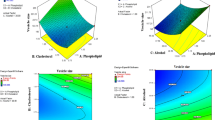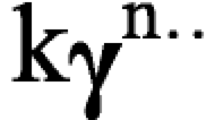Abstract
The present research work explored the possibility of harnessing the benefits of vesicular carriers for overcoming imiquimod-associated complaints or side effects. Hybrid vesicles were prepared by the most common and easily scalable method, i.e., thin film hydration. The chaffing of myriad of factors, both process and material related, affecting the desirable attributes of conceived vesicles, was performed through Taguchi design. Based upon the analysis of Pareto chart and prior experiences, concentration of phospholipid and poloxamer 407 was selected for optimization by 2 levels, 13 run central composite design (CCD). The optimized hybrid vesicles contained 1% w/v phospholipid and 3% w/v poloxamer 407. The optimized hybrid vesicles were incorporated into the 3% w/v carbopol 940 gel and characterized for morphology, physicochemical properties, and rheological behavior. The release (%) and skin retention (% of total dose) across rat skin from gel at same amount of formulation was more than Imiquad®. The gel delivered the loaded cargo, preferably, in the viable region of skin and formed local depot in confocal microscopic studies. The gel followed one compartment open body dermatokinetic model in rat skin. There was not any harmful effect on the mice skin after repeated applications. The gel was stable at room conditions for 1 year.









Similar content being viewed by others
Abbreviations
- CCD:
-
Central composite design
- J ss :
-
Study state permeation flux
- USA:
-
United State of America
- FESEM:
-
Field emission scanning electron microscope
References
Cantisani C, Lazic T, Richetta AG, Clerico R, Mattozzi C, Calvieri S. Imiquimod 5% cream use in dermatology, side effects and recent patents. Recent Patents Inflamm Allergy Drug Discov. 2012;6(1):65–9.
Wagstaff AJ, Perry CM. Topical imiquimod: a review of its use in the management of anogenital warts, actinic keratoses, basal cell carcinoma and other skin lesions. Drugs. 2007;67(15):2187–210.
Walter A, Schäfer M, Cecconi V, Matter C, Urosevic-Maiwald M, Belloni B, et al. Aldara activates TLR7-independent immune defence. Nat Commun. 2013;4:1560.
Tandon Y, Brodell RT. Local reactions to imiquimod in the treatment of basal cell carcinoma. Dermatol Online J. 2012;18(9):1.
Winckle G, Osborne DW. Imiquimod formulation. In: USPTO, editor. USPTO. U.S.A.: Dow Pharmaceutials Science, U.S.A.; 2008.
Alavi M, Karimi N, Safaei M. Application of various types of liposomes in drug delivery systems. Adv Pharm Bull. 2017;7(1):3–9.
Biju SS, Talegaonkar S, Mishra PR, Khar RK. Vesicular systems: an overview. Indian J Pharm Sci. 2006;68(2):141–53.
Bulbake U, Doppalapudi S, Kommineni N, Khan W. Liposomal formulations in clinical use: an updated review. Pharmaceutics. 2017;9(2):12.
Daraee H, Etemadi A, Kouhi M, Alimirzalu S, Akbarzadeh A. Application of liposomes in medicine and drug delivery. Artif Cells Nanomed Biotechnol. 2016;44(1):381–91.
Fox CB, Sivananthan SJ, Duthie MS, Vergara J, Guderian JA, Moon E, et al. A nanoliposome delivery system to synergistically trigger TLR4 AND TLR7. J Nanobiotechnol. 2014;12(17):10.
Ma M, Wang J, Guo F, Lei M, Tan F, Li N. Development of nanovesicular systems for dermal imiquimod delivery: physicochemical characterization and in vitro/in vivo evaluation. J Mater Sci Mater Med. 2015;26(6):191.
Jun S, Huidi Z, Yanting W. Liposome gel preparation capable of inhibiting scar hypertrophy and preparation and application thereof. In: EPO, editor. EPO. China: Univ Guangdong Pharm, Guangzhou, China; 2017.
Cavazzuti M. Design of experiments. In: Cavazzuti M, editor. From theory to design scientific and technological aspects in mechanics. Verlag Berlin Heidelberg: Springer; 2013. p. 13–42.
Singh B, Kumar R, Ahuja N. Optimizing drug delivery systems using systematic “design of experiments.” Part I: fundamental aspects. Crit Rev Ther Drug Carrier Syst. 2004;22(1):27–105.
Garg V, Singh H, Bhatia A, Raza K, Singh SK, Singh B, et al. Systematic development of transethosomal gel system of piroxicam: formulation optimization, in vitro evaluation, and ex vivo assessment. AAPS PharmSciTech. 2017;18(1):58–71.
Kassem MA, Megahed MA, Elyazid SKA, Abd-Allah FI, Abdelghany TM, Al-Abd AM, et al. Enhancing the therapeutic efficacy of tamoxifen citrate loaded span-based nano-vesicles on human breast adenocarcinoma cells. AAPS PharmSciTech. 2018;19(4):1529–43.
Morsi NM, Aboelwafa AA, Dawoud MHS. Enhancement of the bioavailability of an antihypertensive drug by transdermal protransfersomal system: formulation and in vivo study. J Liposome Res. 2018;28(2):137–48.
Donnelly RF, McCarron PA, Zawislak AA, Woolfson AD. Design and physicochemical characterisation of a bioadhesive patch for dose-controlled topical delivery of imiquimod. Int J Pharm. 2006;307(2):318–25.
Zhao B, Rong YZ, Huang XH, Shen JS. Experimental and theoretical study on the structure and electronic spectra of imiquimod and its synthetic intermediates. Bioorg Med Chem Lett. 2007;17(17):4942–6.
Harmonisation IC. Validation of analytical procedures: text and methodology Q2(R1). Geneva, Switzerland: International Conference on Hormonisation; 1996. p. 1–17.
Jagdale S, Pawar S. Gellified emulsion of ofloxacin for transdermal drug delivery system. Adv Pharm Bull. 2017;7(2):229–39.
Raza K, Singh B, Singla S, Wadhwa S, Garg B, Chhibber S, et al. Nanocolloidal carriers of isotretinoin: antimicrobial activity against Propionibacterium acnes and dermatokinetic modeling. Mol Pharm. 2013;10(5):1958–63.
Bhatia A, Raza K, Singh B, Katare OP. Phospholipid-based formulation with improved attributes of coal tar. J Cosmet Dermatol. 2009;8(4):282–8.
Jain A, Jain SK. In vitro release kinetics model fitting of liposomes: an insight. Chem Phys Lipids. 2016;201(1):28–40.
Shargel L, Wu-Pong S, Yu ABC. Applied biopharmaceutics & pharmacokinetics. 5th ed. United State of America: MaGraw-Hill Companies, Inc.; 2004.
Thotakura N, Kumar P, Wadhwa S, Raza K, Katare P. Dermatokinetics as an important tool to assess the bioavailability of drugs by topical nanocarriers. Curr Drug Metab. 2017;18(5):404–11.
Hormonization IC. Stability testing of new drug substances and drug products. Q1A(R2). Geneva, Switzerland: International Conference on Hormonization; 2003. p. 24.
Singh B, Kumar R, Ahuja N. Optimizing drug delivery systems using systematic “design of experiments.” Part I: fundamental aspects. Crit Rev Ther Drug Carrier Syst. 2005;22(1):27–105.
Duman G, Aslan İ, Özer AY, İnanç İ, Taralp A. Liposome, gel and lipogelosome formulations containing sodium hyaluronate. J Liposome Res. 2014;24(4):259–69.
Tan HW, Misran M. Characterization of fatty acid liposome coated with low-molecular-weight chitosan. J Liposome Res. 2012;22(4):329–35.
Acknowledgments
The authors acknowledge Stat-Ease, Inc. Minneapolis, USA, for providing requisite software (Design Expert v10.0) to Mr. Gajanand Sharma, Panjab University, Chandigarh to perform optimization studies with his expert advice. The various department of the Panjab University Chandigarh viz., Department of Geology, Centre for Potential in Excellence in Basic Medical Sciences and UGC Center of Excellence in Applications of Nanomaterials, Nanoparticles and Nanocomposites, and SAIF, CIL, and UCIM as well as sections of UIPS have helped in completing the research work and authors acknowledge the contribution of their authorities, staff, and students.
Funding
This work was supported by the University Grant Commission, New Delhi (F.4-1/2006 (BSR)/5-94/2007 (BSR) dated 03.05.2013 and 7858/UIPS date 14/3/14).
Author information
Authors and Affiliations
Corresponding author
Ethics declarations
All animal studies were approved by Committee for the Purpose of Control and Supervision of Experiments on Animals (CPCSEA) of Panjab University (Approval number- PU/45/99/CPCSEA/IAEC/2018/117).
Conflict of Interest
The authors declare that they have no conflict of interest.
Additional information
Publisher’s Note
Springer Nature remains neutral with regard to jurisdictional claims in published maps and institutional affiliations.
Rights and permissions
About this article
Cite this article
Sharma, M., Sharma, G., Singh, B. et al. Systematically Optimized Imiquimod-Loaded Novel Hybrid Vesicles by Employing Design of Experiment (DoE) Approach with Improved Biocompatibility, Stability, and Dermatokinetic Profile. AAPS PharmSciTech 20, 156 (2019). https://doi.org/10.1208/s12249-019-1331-1
Received:
Accepted:
Published:
DOI: https://doi.org/10.1208/s12249-019-1331-1




